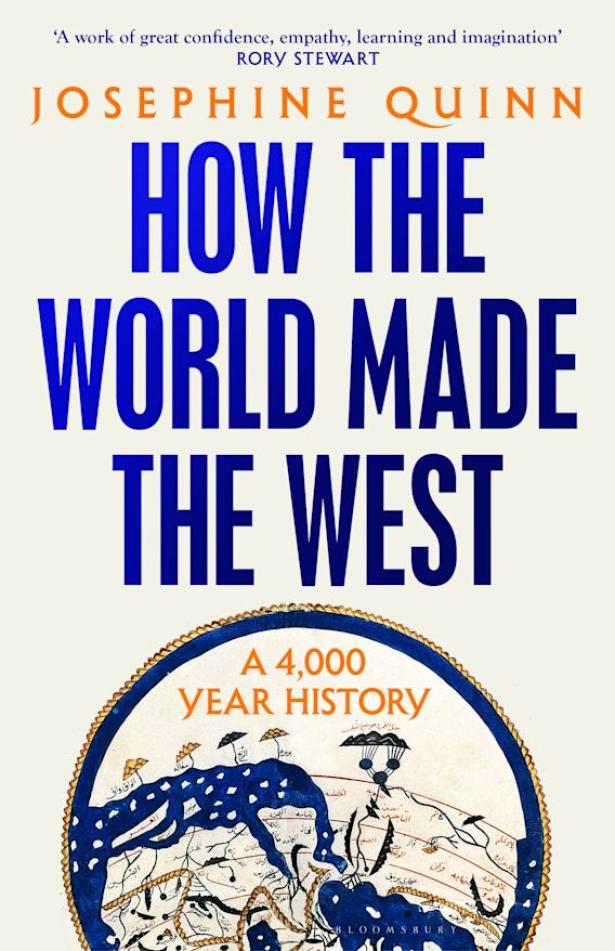How the World Made the West
A 4,000-Year History
Josephine Quinn
Bloomsbury Publishing
ISBN: 978-1526605184
Like the railway and the telegraph, western civilisation was invented in the 19th century. It had located its noble roots in classical Athens and Rome, and from then, so the story went, white Europeans embarked on a smooth progression of gradual sophistication and enlightenment that culminated, not coincidentally, in the glories of the British empire.
That’s not quite how it all got started, argues ancient history professor Josephine Quinn in this fascinating account of the cultural and martial doings around the Mediterranean in the two millennia BC, and thence up to the middle ages. For her, “civilisational thinking” itself is the enemy, not only in historiography but in modern geopolitics. Samuel Huntington’s The Clash of Civilizations (1996), for example, notoriously predicted that future wars would occur not between states but between monolithic and homogeneous “civilisations” such as the “western”, “Islamic”, “African” or “Sinic” (Chinese).
With such relentless trade and travel comes, naturally, cultural commingling. “Overseas exchange meant that Cretans could pick and choose from different cultural options, and they did,” Quinn remarks. Cultural appropriation was not yet an affront; indeed, it could be a strength, as we learn later from Polybius’s remark about the upstart Romans: “They are unusually willing to substitute their own customs for better practice from elsewhere.”
The book is rich in marvellous detail, and succeeds in making the pre-classical world come to life. There is something of the modern wheedling teenager in the complaining minor royal who ends a letter to the king of Egypt with the line “Send me much gold”. This is one of the “Amarna” letters between the monarchs of Egypt, Cyprus, Babylon et al, which Quinn says “reveal the importance of contact and communication between what are usually seen as separate ancient cultures or civilisations”.
But did anybody ever think that ancient cultures existed in hermetical separation, with no contact between them? Here we get to the nub of whether, if there are no monolithic “civilisations”, there are still distinct “cultures”. Sometimes Quinn seems to deny that there are. “Even liberal notions of ‘multiculturalism’,” she complains, “assume the existence, indeed value, of individual ‘cultures’ as a starting point.” But then her own story of continuous “cultural exchange” between peoples around the Mediterranean only makes sense if there are different cultures to begin with; otherwise everything is just a vast heterogeneous soup.
It is plain, at any rate, that identity in that age was fluid and at least partly a matter of choice. A fragment from a lost play by Euripides describes Kadmos, the founder of the city of Thebes, thus: “born Phoenician, he changed his stock to Greek”. (“Stock” here translates the Greek genos, from which we have the word “genes”.)
Culture itself, too, is never created de novo but grows out of wider influence. “There is no doubt,” Quinn shows in a fascinating passage about Homeric echoes of earlier epics, “that the earliest works of Greek literature preserve traces of encounters with a bigger world of song in other languages.” Meanwhile, she writes: “Like the Israelite Exodus from Egypt in the Hebrew Bible, the Iliad is a story about a joint expedition in the distant past that brought a people together as a community, told in a language they share.” It doesn’t seem intellectually criminal, then, to describe “a people brought together as a community”, with a shared language, as a “culture”. Perhaps the argument is not that cultures don’t exist but simply that they had to be invented; that they are socially constructed. Well, yes: how else could they come into being?
Doubtless, though, those fusty 19th-century gentlemen historians were blinkered, in the same way that we shall appear blinkered to historians a century hence. Quinn makes this point beautifully when discussing the “stories of warrior women in the Steppe” in the first millennium BC, which were long dismissed as fantasy by scholars. “There was no room in civilisational thinking for cultures run aggressively and successfully by women,” she observes. “In recent decades, however, more than one hundred women’s graves containing axes, swords and occasionally armour have come to light in Russia and Ukraine.”
If the strong version of Quinn’s thesis – that separate cultures don’t even exist – is dubious, the weak version, that “there has never been a single, pure western or European culture”, remains a valuable point, and her book is full of little gem-like shifts of perspective. Constantine, for example, is described as introducing “an Asian god” (the Christian one) into the Roman empire. Of classical Athens, she writes: “Like pederasty and public nudity, democracy was a distinctive local practice that worked to distinguish some Greek-speaking communities … ” Later, the Crusades, she argues, were not a “clash of civilizations” but rather took place in a world where “culture has no natural location”.
Most of all, this book triumphs as a brilliant and learned challenge to modern western chauvinism. To the extent that we have inherited classical culture, Quinn reminds us, it is in a rather perverted form. (She thinks, and I agree with her, that we should adopt some practices of Athenian democracy such as election by lottery, which “undermined cynical populism”.)
In the end, readers might agree that it’s probably best not to speak of “civilisations”, clashing or otherwise. Let’s use the word only in the singular, to describe something that, as Gandhi once said, would be a good idea.


Spread the word